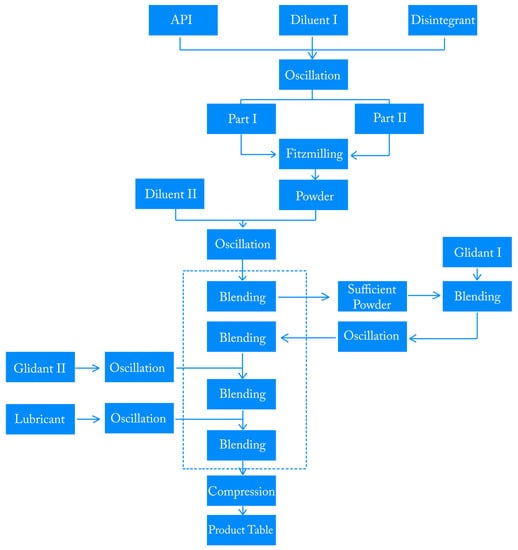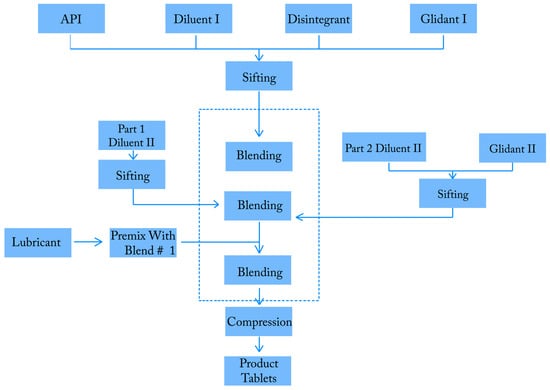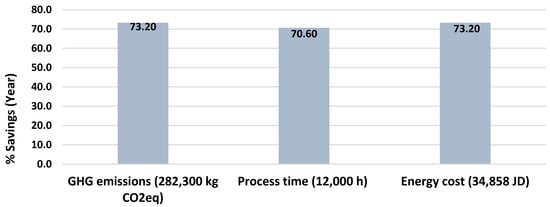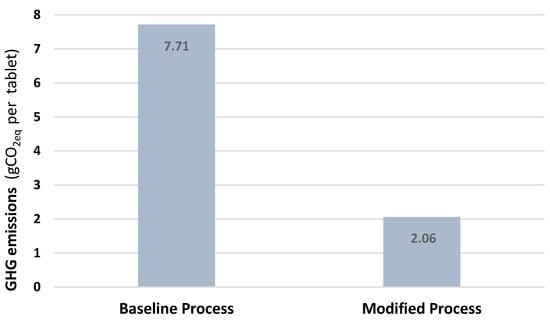Abstract
A process improvement in a tablet manufacturing process within a pharmaceutical industry was carried out based on an eco-efficiency approach. As it is one of the most energy consuming processes in the production line, the tablet manufacturing process was considered. It has the highest production volume with a complicated and long manufacturing product life cycle. Data were collected on energy inputs and emissions data for the stages of powder direct mixing, particle size reduction, and tableting. A straightforward approach was then used to analyze environmental impacts in terms of GHG emissions. Non- added value steps were removed from the product life cycle process, which has led to significant time and cost savings, as well as to a reduction in the emission. Annual economic savings have been achieved, a time reduction of approximately 71% was attained, and the reduction in GHG emissions and energy cost were 73.2%. The g CO2eq per tablet reduction has been calculated within the process improvement to be 2.06 g CO2eq per tablet instead of 7.71 g CO2eq per tablet.
1. Introduction
Tablets are currently among the most common oral solid dosage forms for drugs [1]. The active pharmaceutical ingredient (API) molecule is the limiting factor in the development of an appropriate formulation; hence, the manufacturing process for solid dosage forms varies from compound to compound.
In the competitive environment of business, it is necessary for the compression operation to be efficient in terms of production cost [2,3,4]. Pharmaceutical manufacturing operations are inefficient and costly due to “self-imposed” constraints in the system that lead to low efficiency processes [4,5,6]. Moreover, variability in product quality is caused through insufficient process control; hence, advanced control strategies can be employed to ensure consistent product quality [5,7,8,9].
“Eco-efficiency” is a term that does not yet appear in dictionaries but has already gained considerable force in shaping the environmental policies and practices of leading corporations. Pharmaceutical industries should find the eco-efficiency assessment instrumental to systematically identifying opportunities to increase energy efficiency and decrease waste generation. Consequently, this leads to positive change in sustainable production and consumption [10,11,12,13]. It is a well-used and proven approach to identify cost saving energy conservation and pollution prevention technologies that enhance a facility’s performance.
The tableting process, through which a small quantity of powder is processed to form a tablet, is quite common in pharmaceutical industries. It includes direct compression, dry granulation, and wet granulation. Dry granulation may be used if the materials have sufficient inherent binding or cohesive properties to form granules without the use of liquids. Direct compression is defined as the process by which tablets are compressed directly from a powder mixture of API and suitable excipients.
Direct compression is considered the most efficient process as compared to other processes, since it involves only dry blending and compaction of API with necessary excipients, reduces processing time, reduces labour costs, and includes fewer manufacturing steps, a smaller amount of equipment, and less process validation. It also reduces power consumption and eliminates heat and moisture, thus increasing not only the stability, but also the suitability for moisture-sensitive API’s particle size uniformity [14].
The tablet direct compression and tableting operations require the use of significant amounts of both energy and time and, most importantly, release greenhouse gas (GHG) emissions into the environment. In order to reduce the emissions into the atmosphere, pharmaceutical manufacturing processes can be changed and improved by eliminating the use of a variety of organic solvents [15,16].
Process modification and technological changes to improve production efficiency and reduce the impact on the environment are of significant importance in many industries, as well as in pharmaceutical manufacturing. This has been investigated using different tools and concepts: waste reduction (WAR) algorithm [17], the product Life Cycle Assessment tool [18], cleaner production concept [15,19,20], and ISO14001 [21].
The influx of refugees into in Jordan, coupled with the increasing demand for energy, while the energy supply in Jordan depends on about 96% on imports of oil, oil products, natural gas, and electricity, have caused a significantly increased economic burden in Jordan [22,23,24,25,26,27,28,29,30]. The industrial sector consumes 17% of the final energy demand (5.38 Mtoe), and 24% of the electricity demand in Jordan [22]. Eco-efficiency and cleaner production measures in the industrial sector are therefore very critical for energy efficiency and pollution reduction in Jordan [22].
In the present study, the direct compression process was selected to be thoroughly investigated using the eco-efficiency approach due to its high volume production rate in the chosen pharmaceutical tablet manufacturing process, to achieve more energy efficiency and, consequently, to release fewer emissions into the environment.
2. Materials and Methods
The assessment has been carried out following the Guide to Industrial Assessment for Pollution Prevention and Energy Efficiency to facilitate the assessment [31,32,33]. Several detailed visits were carried out to collect necessary data and to establish the material and energy flow analyses. Moreover, the study assessment covers all the production steps with main focus on the energy consumption and materials flow analysis of the processes. The greenhouse gas emissions were calculated using IPCC Guidelines for national greenhouse gas inventories [34].
2.1. Overview of the Manufacturing Process
A pharmaceutical company located in Amman, Jordan, was selected for undertaking the present study. The company has a multinational business, developing, manufacturing, and marketing generic, branded, and injectable pharmaceuticals on a global scale.
The pharmaceutical tablet processes in the company were the focus of the present study, in which the tablet direct compression and tableting operations require the use of significant amounts of both energy and time and, most importantly, the GHG emissions into the environment. In order to achieve our objectives to reduce the emissions and energy consumption in a pharmaceutical manufacturing process, there are several techniques and practices that are possible to implement, such as processes improving methods, raw material change, equipment modification, better process control, good housekeeping, and technology change.
The tableting process involves the compaction of powder blends to form a hard compact.
As shown in Figure 1, the pharmaceutical tablet process originally includes many complicated steps, namely size reductions steps for the raw materials (API and excipients) using the oscillator and Fitz miller, and blending the powder mixture every time the excipients are be added. The final blend is directly compressed to form tablets by single punch compression machine. However, material properties can significantly affect tableting performance. For instance, broad particle size distributions or density variability can result in segregation causing non-uniform tablet composition during die filling [5]. Furthermore, tablet weight variability and insufficient tablet hardness might result due to low bulk density, poor compressibility, or flow properties, which affect die filling and the pressure profile during compaction [5,35,36].

Figure 1.
Baseline pharmaceutical tablet processes block diagram.
2.2. Consumption
According to the steps of eco-efficiency assessment steps, each process unit was surveyed in terms of energy consumption and operating time. The primary investigated data, which provide important information for the process analysis, are shown in Table 1. The blending (including oscillation and fitzmilling) and tableting (direct compression) steps consumed most of the energy and time required. The baseline pharmaceutical tablet processes require 170 h and consume 5600 kWh for one tables’ manufacturing batch.

Table 1.
Summary of baseline pharmaceutical tablet process units‘ data per batch.
3. Results and Discussion
Process was changed to include fewer steps and more simple steps. It is found that the oscillator and Fitz miller have a mesh size of around 600 µm, while the particle size diameter of the product powder equals or is less than 100 µm; therefore, there is no need in this case study process to use them, because the homogeneity of the powder is not affected and the sifter is used instead of them. The size reduction steps were removed, with no effects on the product quality. However, as stated before, the particle size distribution has significant impact on tableting performance.
The blending steps are reduced. The compression machine is changed from single punch to triple punch, leading to a threefold increase in efficiency, as it is shown in Figure 2. This process requires 50 h and consumption of 1499 kWh to manufacture one batch. (See Table 2).

Figure 2.
Manufacturing process flow chart after improvement.

Table 2.
Summary of manufacturing process units of the product per batch after improvement based on 2013 data.
The effects of changing the process: It was found that the operating time of the manufacturing process units (blending (in addition to oscillation and sifter units) and tableting) per batch was reduced from 170 h to 50 h with a 70.6% reduction. Moreover, the energy consumption was reduced from 5600 kWh per batch to 1499 kWh per batch with a 73.2% reduction. The amount of emissions was calculated to be 1032 kg CO2eq per batch instead of 3855 kg CO2eq per batch, knowing that the company produces 100 batches of this product per year, resulting in savings of 34,858 JOD in 2013, as shown in Table 3 and Figure 3.

Table 3.
The energy consumed and emissions comparison in old process and new process.

Figure 3.
Percentual savings in process time, energy cost, and GHG emissions due to process improvement.
Figure 4 demonstrates the g CO2eq per tablet reduction that has been calculated within the process improvement to be 2.06 g CO2eq per tablet instead of 7.71 g CO2eq per tablet.

Figure 4.
GHG emissions comparison in old process and new process for one tablet produced.
4. Conclusions
Pharmaceutical manufacturing industries need to employ innovation, cutting edge scientific and engineering knowledge, and the best principles of quality management to respond to the challenges of new discoveries.
Although tablet manufacturing is a well-established technology, its improvements, however, in some cases, have come with more stringent requirements for material and process control. This study resulted in the improvement of the environmental and economic performance in terms of energy consumption, GHG emissions reduction, and time consuming processes. The influence of process improvement on minimizing process time, cost, and GHG emissions on pharmaceutical tablet manufacturing processes has resulted in a significant improvement in the energy consumption, process time, and cost reduction performance. Moreover, a true comparison between the old process and the new process has demonstrated a major reduction in GHG emissions, which shows that applying simple tools and strategies accordingly leads to a large business impact.
Author Contributions
Motasem Saidan: Data analysis, results representation, and paper writing. Tala Al-Talafha: Site visits and process assessment. Manar Al-Naerat: Site visists and data gathering. Hakam Saidan: Financial analysis and eco-efficiency analysis. Ahmed Al-Salaymeh: Data analysis. Muna Hindiyeh: Data analysis.
Conflicts of Interest
The authors declare no conflict of interest.
References
- Järvinen, M.A.; Paaso, J.; Paavola, M.; Leiviskä, K.; Juuti, M.; Muzzio, F.; Järvinen, K. Continuous direct tablet compression: Effects of impeller rotation rate, total feed rate and drug content on the tablet properties and drug release. Drug Dev. Ind. Pharm. 2012, 39, 1802–1808. [Google Scholar] [CrossRef] [PubMed]
- Suresh, P.; Basu, P.K. Improving pharmaceutical product development and manufacturing: Impact on cost of drug development and cost of goods sold of pharmaceuticals. J. Pharm. Innov. 2008, 3, 175–187. [Google Scholar] [CrossRef]
- Shah, N. Pharmaceutical supply chains: Key issues and strategies for optimisation. Comput. Chem. Eng. 2004, 28, 929–941. [Google Scholar] [CrossRef]
- McKenzie, P.; Kiang, S.; Tom, J.; Rubin, A.E.; Futran, M. Can pharmaceutical process development become high tech? AIChE J. 2006, 52, 3990–3994. [Google Scholar] [CrossRef]
- Amanda, J.; Rogers, A.H.; Ierapetritou, G.M. Modeling of Particulate Processes for the Continuous Manufacture of Solid-Based Pharmaceutical Dosage Forms. Processes 2013, 1, 67–127. [Google Scholar] [CrossRef]
- Basu, P.; Joglekar, G.; Rai, S.; Suresh, P.; Vernon, J. Analysis of manufacturing costs in pharmaceutical companies. J. Pharm. Innov. 2008, 3, 30–40. [Google Scholar] [CrossRef]
- Plumb, K. Continuous processing in the pharmaceutical industry—Changing the mindset. Chem. Eng. Res. Des. 2005, 83, 730–738. [Google Scholar] [CrossRef]
- Buchholz, S. Future manufacturing approaches in the chemical and pharmaceutical industry. Chem. Eng. Process. Process Intensif. 2010, 49, 993–995. [Google Scholar] [CrossRef]
- Singh, R.; Ierapetritou, M.; Ramachandran, R. An engineering study on the enhanced control and operation of continuous manufacturing of pharmaceutical tablets via roller compaction. Int. J. Pharm. 2012, 438, 307–326. [Google Scholar] [CrossRef] [PubMed]
- Schmidheiny, S. Changing Course; MIT Press: Cambridge, MA, USA, 1992. [Google Scholar]
- Ciccozzi, E.; Checkenya, R.; Rodriguez, A.V. Recent experiences and challenges in promoting cleaner production investments in developing countries. J. Clean. Prod. 2003, 11, 629–638. [Google Scholar] [CrossRef]
- Kjaerheim, G. Cleaner production and sustainability. J. Clean. Prod. 2005, 13, 329–339. [Google Scholar] [CrossRef]
- Sangwon, S.; Kun Mo, L.; Sangsun, H. Eco-efficiency for pollution prevention in small to medium-sized enterprises: A case from South Korea. J. Ind. Ecol. 2005, 9, 223–240. [Google Scholar]
- Rana, A.; Khokra, S.L.; Chandel, A.; Nanda, G.P.; Sahu, R.K. Overview On Roll Compaction/Dry Granulation Process. Pharmacologyonline 2011, 3, 286–298. [Google Scholar]
- Boltic, Z.; Ruzic, N.; Jovanovic, M.; Savic, M.; Jovanovic, J.; Petrovic, S. Cleaner production aspects of tablet coating process in pharmaceutical industry: Problem of VOCs emission. J. Clean. Prod. 2013, 44, 123–132. [Google Scholar] [CrossRef]
- Basu, S.; Mukhopadhyay, S.K.; Gangopadhyay, A.; Dastidar, S.G. Materials Saving and Waste Minimization in Indian Pharmaceutical Industries. Res. J. Pharm. Sci. 2013, 2, 20–25. [Google Scholar]
- Young, D.; Scharp, R.; Cabezas, H. The waste reduction (WAR) algorithm: Environmental impacts, energy consumption, and engineering economics. Waste Manag. 2000, 20, 605–615. [Google Scholar] [CrossRef]
- Mata, T.M.; Martins, A.A.; Neto, B.; Martins, M.L.; Salced, R.L.R.; Costa, C.A.V. LCA Tool for Sustainability Evaluations in the Pharmaceutical Industry. Chem. Eng. Trans. 2012, 26, 261–266. [Google Scholar]
- Miao, Z.; Bian, N.; Dong, L.; Sun, W. Exploring execution of ecological engineering and cleaner production in pharmaceutical industry. Energy Procedia 2011, 5, 679–683. [Google Scholar]
- Li, Z.D.; Zhang, S.-S.; Zhang, Y.; Zhang, Y.; Wei, L. Evaluation of cleaner production audit in pharmaceutical production industry: Case study of the pharmaceutical plant in Dalian, P.R. China. Clean Technol. Environ. Policy 2011, 13, 195–206. [Google Scholar]
- Searcy, C.; Morali, O.; Karapetrovic, S.; Wichuk, K.; McCartney, D.; McLeod, S.; Fraser, D. Challenges in implementing a functional ISO 14001 environmental management system. Int. J. Qual. Reliab. Manag. 2011, 29, 779–796. [Google Scholar] [CrossRef]
- Saidan, M. Sustainable Energy Mix and Policy Framework for Jordan; Friedrich Ebert Stiftung: Amman, Jordan, 2012. [Google Scholar]
- Al-Hamamre, Z.; Saidan, M.; Hararah, M.; Rawajfeh, K.; Alkhasawneh, H.; Al-Shannag, M. Wastes and biomass materials as sustainable-renewable energy resources for Jordan. Renew. Sustain. Energy Rev. 2017, 67, 295–314. [Google Scholar] [CrossRef]
- Saidan, M.; Tarawneh, A. Estimation of Potential E-waste Generation in Jordan. Ekoloji Derg. 2015, 24, 60–64. [Google Scholar] [CrossRef]
- Hararah, M.A.; Saidan, M.N.; Alhamamre, Z.; Abu-Jrai, A.M.; Alsawair, J.; Damra, R.A. The PCDD/PCDF emission inventory in Jordan: Aqaba city. J. Chem. Technol. Metall. 2016, 51, 112–120. [Google Scholar]
- Saidan, M.N.; Al-Weshah, R.A.; Obada, I. Potential Rainwater Harvesting: Adaptation Measure for Urban Areas in Jordan. Am. Water Works Assoc. 2015, 107, 594–602. [Google Scholar] [CrossRef]
- Saidan, M.N.; Abu Drais, A.; Al-Manaseer, E. Solid waste composition analysis and recycling evaluation: Zaatari Syrian Refugees Camp, Jordan. Waste Manag. 2017, 61, 58–66. [Google Scholar] [CrossRef] [PubMed]
- Tarawneh, A.; Saidan, M. Households Awareness, Behaviors, and Willingness to Participate in E-waste Management in Jordan. Int. J. Ecosyst. 2013, 3, 124–131. [Google Scholar]
- Saidan, M.; Khasawneh, H.J.; Tayyem, M.; Hawari, M. Getting Energy from Poultry Waste in Jordan: Cleaner Production Approach. J. Chem. Technol. Metall. 2017, 52, 595–601. [Google Scholar]
- Saidan, M.N.; Ansour, L.M.; Saidan, H. Management of Plastic Bags Waste: An assessment of scenarios in Jordan. J. Chem. Technol. Metall. 2017, 52, 148–154. [Google Scholar]
- United States Environmental Protection Agency (EPA). Guide to Industrial Assessment for Pollution Prevention and Energy Efficiency; EPA/625/R-99/003; EPA: Washington, DC, USA, 2001. [Google Scholar]
- National Development and Reform Commission (NDRC). Interim Measures of Cleaner Production Auditing; Ministry of Environmental Protection of the People’s Republic of China (MEPC): Beijing, China, 2004.
- Guo, X.; Zhang, X.; Fang, P. Cleaner Production Audit Guide; China Environmental Science Press: Beijing, China, 2007. [Google Scholar]
- Intergovernmental Panel on Climate Change (IPCC). IPCC Guidelines for National Greenhouse Gas Inventories. In National Greenhouse Gas Inventory Programme; Eggleston, H.S., Buendia, L., Miwa, K., Ngara, T., Tanabe, K., Eds.; The Initial Graphics Exchange Specification (IGES): Hayama, Japan, 2006. [Google Scholar]
- Mehrotra, A.; Chaudhuri, B.; Faqih, A.; Tomassone, M.S.; Muzzio, F.J. A modeling approach for understanding effects of powder flow properties on tablet weight variability. Powder Technol. 2009, 188, 295–300. [Google Scholar] [CrossRef]
- Kuentz, M.; Lunenberger, H. A new model for the hardness of a compacted particle systems, applied to tablets of pharmaceutical polymers. Powder Technol. 2000, 111, 145–153. [Google Scholar] [CrossRef]
© 2018 by the authors. Licensee MDPI, Basel, Switzerland. This article is an open access article distributed under the terms and conditions of the Creative Commons Attribution (CC BY) license (http://creativecommons.org/licenses/by/4.0/).